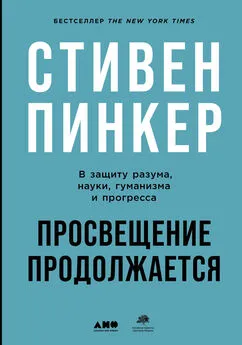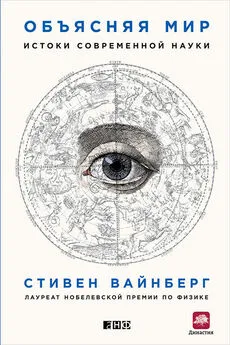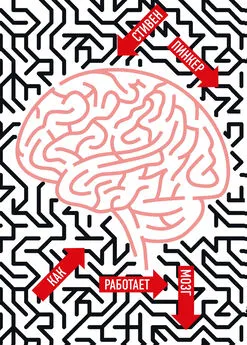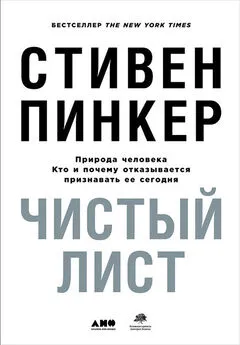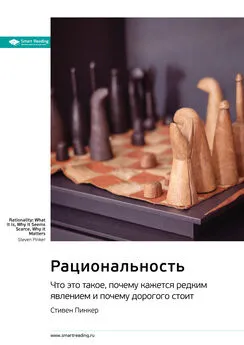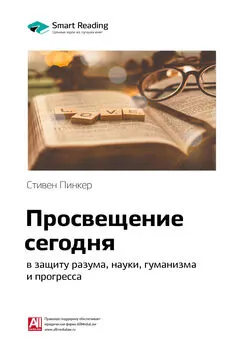Стивен Пинкер - Просвещение продолжается. В защиту разума, науки, гуманизма и прогресса
- Название:Просвещение продолжается. В защиту разума, науки, гуманизма и прогресса
- Автор:
- Жанр:
- Издательство:Альпина нон-фикшн
- Год:2021
- Город:Москва
- ISBN:9785001395362
- Рейтинг:
- Избранное:Добавить в избранное
-
Отзывы:
-
Ваша оценка:
Стивен Пинкер - Просвещение продолжается. В защиту разума, науки, гуманизма и прогресса краткое содержание
Этот прогресс – не случайность и не результат действия внешних сил. Это дар современному миру от деятелей Просвещения, которые первыми додумались, что знания можно использовать во имя процветания всего человечества. Идеи Просвещения – вовсе не наивные мечтания. Наоборот, они сработали – и это неоспоримый факт. Тем не менее именно сейчас эти идеи особенно нуждаются в нашей защите, поскольку противостоят характерным недостаткам человеческой природы – трайбализму, авторитаризму, демонизации чужаков и магическому мышлению, – которые так нравится эксплуатировать современным демагогам. Да, стоящие перед человечеством проблемы огромны, но все они решаемы, если мы, продолжая дело Просвещения, используем для этого разум, доверяем науке и руководствуемся идеалами гуманизма.
Особенности
Более 70 графиков из почти всех областей человеческой жизни.
Для кого
Для поклонников Стивена Пинкера. Для всех, кто интересуется природой человека. Для тех, кто верит в прогресс, и для тех, кто в нем сомневается.
Просвещение продолжается. В защиту разума, науки, гуманизма и прогресса - читать онлайн бесплатно ознакомительный отрывок
Интервал:
Закладка:
Berlin, I. 1988/2013. The pursuit of the ideal. In I. Berlin, ed., The crooked timber of humanity . Princeton, NJ: Princeton University Press.
Berman, P. 2010. The flight of the intellectuals . New York: Melville House.
Bernanke, B. S. 2016. How do people really feel about the economy? Brookings Blog . https://www.brookings.edu/blog/ben-bernanke/2016/06/30/how-do-people-really-feel-about-the-economy/.
Berry, K., Lewis, P., Pelopidas, B., Sokov, N., & Wilson, W. 2010. Delegitimizing nuclear weapons: Examining the validity of nuclear deterrence . Monterey, CA: Monterey Institute of International Studies. Besley, T. 2006. Health and democracy. American Economic Review, 96, 313–18.
Bettmann, O. L. 1974. The good old days – they were terrible! New York: Random House.
Betzig, L. 1986. Despotism and differential reproduction . Hawthorne, NY: Aldine de Gruyter.
Bird, A. 2011. Thomas Kuhn. In E. N. Zalta, ed., Stanford Encyclopedia of Philosophy . https://plato.stanford.edu/entries/thomas-kuhn/.
Blackmore, S. 1991. Near eath experiences: In or out of the body? Skeptical Inquirer, 16, 34–45.
Blair, J. P., & Schweit, K. W. 2014. A study of active shooter incidents, 2000–2013 . Washington: Federal Bureau of Investigation.
Blees, T. 2008. Prescription for the planet: The painless remedy for our energy and environmental crises . North Charleston, SC: Booksurge.
Blight, J. G., Nye, J. S., & Welch, D. A. 1987. The Cuban Missile Crisis revisited. Foreign Affairs, 66, 170–88.
Blinkhorn, S. 1982. Review of S. J. Gould’s “The mismeasure of man.” Nature, 296, 506.
Block, N. 1986. Advertisement for a semantics for psychology. In P. A. French, T. E. Uehling, & H. K. Wettstein, eds., Midwest studies in philosophy: Studies in the philosophy of mind (vol. 10). Minneapolis: University of Minnesota Press.
Block, N. 1995. On a confusion about a function of consciousness. Behavioral and Brain Sciences, 18, 227–87.
Bloom, P. 2012. Religion, morality, evolution. Annual Review of Psychology, 63, 179–99.
Bloomberg, M., & Pope, C. 2017. Climate of hope: How cities, businesses, and citizens can save the planet . New York: St. Martin’s Press.
Bluth, C. 2011. The myth of nuclear proliferation . School of Politics and International Studies, University of Leeds.
Bohle, R. H. 1986. Negativism as news selection predictor. Journalism Quarterly, 63, 789–96.
Bond, M. 2009. Risk school. Nature, 461 .
Bostrom, A., Morgan, M. G., Fischhoff, B., & Read, D. 1994. What do people know about global climate change? 1. Mental models. Risk Analysis, 14, 959–71.
Bostrom, N. 2016. Superintelligence: Paths, dangers, strategies . New York: Oxford University Press. Botello, M. A. 2016. Mexico, tasa de homicidios por 100 mil habitantes desde 1931 a 2015. Mexico-Maxico . http://www.mexicomaxico.org/Voto/Homicidios100M.htm.
Bourget, D., & Chalmers, D. J. 2014. What do philosophers believe? Philosophical Studies, 170, 465–500. Bourguignon, F., & Morrison, C. 2002. Inequality among world citizens, 1820–1992. American Economic Review, 92, 727–44.
Bowering, G. 2015. Islamic political thought: An introduction . Princeton, NJ: Princeton University Press. Boyd, B., Carroll, J., & Gottschall, J., eds. 2010. Evolution, literature, and film: A reader . New York: Columbia University Press.
Boyd, R. 1988. How to be a moral realist. In G. Sayre cCord, ed., Essays on moral realism . Ithaca, NY: Cornell University Press.
Boyer, Pascal. 2001. Religion explained: The evolutionary origins of religious thought . New York: Basic Books.
Boyer, Paul. 1985/2005. By the bomb’s early light: American thought and culture at the dawn of the Atomic Age . Chapel Hill: University of North Carolina Press.
Boyer, Paul. 1986. A historical view of scare tactics. Bulletin of the Atomic Scientists, 17–19.
Braithwaite, J. 2008. Near death experiences: The dying brain. Skeptic, 21 (2). http://www.critical-thinking.org.uk/paranormal/near-death-experiences/the-dying-brain.php.
Braman, D., Kahan, D. M., Slovic, P., Gastil, J., & Cohen, G. L. 2007. The Second National Risk and Culture Study: Making sense of – and making progress in – the American culture war of fact. GW Law Faculty Publications and Other Works, 211 . http://scholarship.law.gwu.edu/facultypublications/211.
Branch, T. 1988. Parting the waters: America in the King years, 1954–63 . New York: Simon & Schuster.
Brand, S. 2009. Whole Earth discipline: Why dense cities, nuclear power, transgenic crops, restored wildlands, and geoengineering are necessary . New York: Penguin.
Brandwen, G. 2016. Terrorism is not effective. Gwern.net. https://www.gwern.net/Terrorism-is-not-Effective.
Braudel, F. 2002. Civilization and capitalism, 15th–18th century (vol. 1: The structures of everyday life ). London: Phoenix Press.
Bregman, A. S. 1990. Auditory scene analysis: The perceptual organization of sound. Cambridge, MA: MIT Press.
Bregman, R. 2017. Utopia for realists: The case for a universal basic income, open borders, and a 15-hour workweek . Boston: Little, Brown.
Brennan, J. 2016. Against democracy. National Interest, Sept. 7.
Brickman, P., & Campbell, D. T. 1971. Hedonic relativism and planning the good society. In M. H. Appley, ed., Adaptation evel theory: A symposium . New York: Academic Press.
Briggs, J. C. 2015. Re: Accelerated modern human nduced species losses: Entering the sixth mass extinction. Science . http://advances.sciencemag.org/content/1/5/e1400253.e-letters.
Briggs, J. C. 2016. Global biodiversity loss: Exaggerated versus realistic estimates. Environmental Skeptics and Critics, 5, 20–27.
Brink, D. O. 1989. Moral realism and the foundations of ethics . New York: Cambridge University Press. British Petroleum. 2016. BP Statistical Review of World Energy 2016, June.
Brockman, J. 1991. The third culture. Edge . https://www.edge.org/conversation/johnbrockman-the-third-culture.
Brockman, J., ed. 2003. The new humanists: Science at the edge . New York: Sterling.
Brockman, J., ed. 2015. What to think about machines that think? Today’s leading thinkers on the age of ma-chine intelligence . New York: HarperPerennial.
Brooks, R. 2015. Mistaking performance for competence misleads estimates of AI’s 21st century promise and danger. Edge . https://www.edge.org/response-detail/26057.
Brooks, R. 2016. Artificial intelligence. Edge . https://www.edge.org/response-detail/26678.
Brown, A., & Lewis, J. 2013. Reframing the nuclear de lerting debate: Towards maximizing presidential decision time. Nuclear Threat Initiative . http://nti.org/3521A.
Brown, D. E. 1991. Human universals. New York: McGraw-Hill.
Brown, D. E. 2000. Human universals and their implications. In N. Roughley, ed., Being humans: Anthropological universality and particularity in transdisciplinary perspectives . New York: Walter de Gruyter.
Brunnschweiler, C. N., & Lujala, P. 2015. Economic backwardness and social tension. University of East Anglia. https://ideas.repec.org/p/uea/aepppr/201272.html.
Bryce, R. 2014. Smaller faster lighter denser cheaper: How innovation keeps proving the catastrophists wrong . New York: Perseus.
Brynjolfsson, E., & McAfee, A. 2015. Will humans go the way of horses? Foreign Affairs, July/Aug.
Brynjolfsson, E., & McAfee, A. 2016. The Second Machine Age: Work, progress, and prosperity in a time of brilliant technologies . New York: Norton.
Bulletin of the Atomic Scientists . 2017. Doomsday Clock timeline. http://thebulletin.org/timeline.
Bunce, V. 2017. The prospects for a color revolution in Russia. Daedalus, 146, 19–29.
Bureau of Labor Statistics. 2016a. Census of fatal occupational injuries. https://www.bls.gov/iifoshcfoi1.htm.
Bureau of Labor Statistics. 2016b. Charts from the American Time Use Survey. https://www.bls.gov/tus/charts/.
Bureau of Labor Statistics. 2016c. Time spent in primary activities and percent of the civilian population engaging in each activity, averages per day by sex, 2015. https://www.bls.gov/news.release/atus.t01.htm.
Bureau of Labor Statistics. 2017. College enrollment and work activity of 2016 high school graduates. https://www.bls.gov/news.release/hsgec.nr0.htm.
Buringh, E., & Van Zanden, J. 2009. Charting the “rise of the West”: Manuscripts and printed books in Europe, a long erm perspective from the sixth through eighteenth centuries. Journal of Economic History, 69, 409–45.
Burney, D. A., & Flannery, T. F. 2005. Fifty millennia of catastrophic extinctions after human contact. Trends in Ecology and Evolution, 20, 395–401.
Burns, J. 2009. Goddess of the market: Ayn Rand and the American right . New York: Oxford University Press.
Burtless, G. 2014. Income growth and income inequality: The facts may surprise you. Brookings Blog . https://www.brookings.edu/opinions/income-growth-and-income-inequality-the-facts-may-surprise-you/.
Buturovic, Z., & Klein, D. B. 2010. Economic enlightenment in relation to college oing, ideology, and other variables: A Zogby survey of Americans. Economic Journal Watch, 7, 174–96.
Calic, R., ed. 1971. Secret conversations with Hitler: The two newly iscovered 1931 interviews . New York: John Day.
Caplan, B. 2007. The myth of the rational voter: Why democracies choose bad policies . Princeton, NJ: Princeton University Press.
Caplow, T., Hicks, L., & Wattenberg, B. 2001. The first measured century: An illustrated guide to trends in America, 1900–2000 . Washington: AEI Press.
CarbonBrief. 2016. Explainer: 10 ways “negative emissions” could slow climate change. https://www.carbonbrief.org/explainer-10-ways-negative-emissions-could-slow-climate-change.
Carey, J. 1993. The intellectuals and the masses: Pride and prejudice among the literary intelligentsia, 1880–1939 . New York: St. Martin’s Press.
Carey, M., Jackson, M., Antonello, A., & Rushing, J. 2016. Glaciers, gender, and science. Progress in Human Geography, 40, 770–93.
Carey, S. 2009. Origins of concepts . Cambridge, MA: MIT Press.
Carlson, R. H. 2010. Biology is technology: The promise, peril, and new business of engineering life . Cambridge, MA: Harvard University Press.
Carroll, S. M. 2016. The big picture: On the origins of life, meaning, and the universe itself . New York: Dutton.
Carter, R. 1966. Breakthrough: The saga of Jonas Salk. Trident Press.
Carter, S. B., Gartner, S. S., Haines, M. R., Olmstead, A. L., Sutch, R., et al., eds. 2000. Historical statistics of the United States: Earliest times to the present (vol. 1, part A: Population). New York: Cambridge University Press.
Case, A., & Deaton, A. 2015. Rising morbidity and mortality in midlife among white non-Hispanic Americans in the 21st century. Proceedings of the National Academy of Sciences, 112, 15078–83.
Center for Systemic Peace. 2015. Integrated network for societal conflict research data page. http://www.systemicpeace.org/inscr/inscr.htm.
Centers for Disease Control. 1999. Improvements in workplace safety – United States, 1900–1999. CDC Morbidity and Mortality Weekly Report, 48, 461–69.
Читать дальшеИнтервал:
Закладка:
